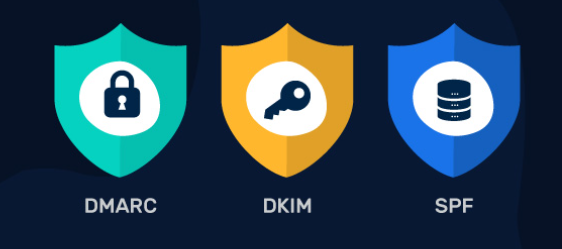Email remains one of the most important communication tools for businesses. However, it’s also a common vector for cyberattacks, phishing, spoofing, and spam. If you’ve ever had customers report that your email landed in their spam folders or received suspicious messages that appear to come from your domain, you’ve likely encountered problems that Sender Policy Framework (SPF), DomainKeys Identified Mail (DKIM), and Domain-based Message Authentication, Reporting, and Conformance (DMARC) are designed to solve.
In this post, we’ll break down SPF, DKIM, and DMARC in simple terms, explain why each is important, and walk you through how to implement them to secure your business email.
Why Email Authentication Matters
Without proper authentication, cybercriminals can forge your domain name to send phishing emails to your customers, vendors, or employees. These emails can damage your reputation, cause financial loss, and result in blacklisting by email service providers.
Authentication protocols like SPF, DKIM, and DMARC are essential for verifying that your emails are coming from you—and stopping malicious senders from impersonating your domain.
What Is SPF?
SPF (Sender Policy Framework) is a DNS record that specifies which mail servers are allowed to send emails on behalf of your domain. It helps receiving mail servers detect forged “from” addresses.
When an email is received, the recipient’s mail server checks your domain’s SPF record to confirm that the sending server is authorized. If it’s not listed, the server may flag or reject the message.
Benefits of SPF:
Prevents spoofed emails from your domain.
Reduces the chance of your emails being marked as spam.
Protects your brand’s credibility.
How to Set Up SPF:
You’ll need to access your domain’s DNS settings and add a TXT record. A basic SPF record looks like this:
v=spf1 include:_spf.google.com ~allThis example authorizes Google’s mail servers to send on your behalf. The ~all tag means emails from unauthorized servers will be marked as “soft fail” (i.e., possibly spam).
What Is DKIM?
DKIM (DomainKeys Identified Mail) adds a digital signature to your email headers. It allows the receiving server to verify that the message hasn’t been altered during transit and confirms that it was genuinely sent from your domain.
DKIM works by using a private key to encrypt the signature and a public key published in your DNS to allow the recipient to verify it.
Benefits of DKIM:
-Verifies the authenticity of email content.
-Adds a second layer of protection after SPF.
-Increases trustworthiness with email providers like Gmail, Outlook, and Yahoo.
How to Set Up DKIM:
Your email provider (e.g., Google Workspace, Microsoft 365, Zoho Mail) usually generates the DKIM key pair and provides instructions to add a TXT record to your DNS. Once configured, outgoing emails will be signed automatically.
What Is DMARC?
DMARC (Domain-based Message Authentication, Reporting, and Conformance) builds on SPF and DKIM. It tells receiving mail servers what to do if an email fails SPF or DKIM checks and allows you to receive reports on these failures.
DMARC policies can be set to:
none: Monitor only.
quarantine: Move suspicious emails to spam.
reject: Block emails that fail authentication.
Benefits of DMARC:
-Enforces your SPF and DKIM policies.
-Provides visibility into who is sending emails using your domain.
-Prevents phishing attacks from reaching your customers.
How to Set Up DMARC:
Add a DMARC TXT record in your DNS. A basic DMARC policy might look like:
v=DMARC1; p=reject; rua=mailto:dmarc-reports@yourdomain.com
This policy tells servers to reject emails that fail SPF and DKIM checks and to send you daily reports.
Why All Three Work Best Together
Using SPF, DKIM, and DMARC together creates a strong email authentication system. Each one addresses different risks:
SPF confirms that the sending server is allowed.
DKIM ensures the message wasn’t altered.
DMARC enforces rules and provides reports.
Alone, each method can improve your email security, but together they significantly reduce the risk of impersonation and improve deliverability.
Common Mistakes to Avoid
Misconfigured DNS Records: Even a small error in syntax can break your SPF or DKIM setup. Always test your records after publishing.
Too Many DNS Lookups: SPF has a limit of 10 DNS lookups. If you exceed it, your SPF record will break.
Forgetting Monitoring First: Before setting your DMARC policy to “reject,” it’s best to start with “none” and analyze the reports to ensure legitimate senders are not blocked.
Inconsistent Alignment: For DMARC to pass, the domain in the “From” address must align with the domains used in SPF and DKIM. Misalignment causes DMARC failures.
Tools to Help You
MXToolbox: Check SPF, DKIM, and DMARC records.
Google Postmaster Tools: For domain owners using Google Workspace.
DMARC Analyzer: Offers in-depth visibility into email authentication reports.
Mail-tester.com: Test your emails for SPF, DKIM, and spam score.
Final Thoughts
Securing your business email is no longer optional. With email fraud on the rise, SPF, DKIM, and DMARC offer vital protection for your communications and brand reputation. While setting up these records may require some initial technical steps, the long-term benefits—including better email deliverability, customer trust, and protection from spoofing—make it well worth the effort.
Start by verifying whether your domain has SPF, DKIM, and DMARC records in place. If not, work with your hosting provider or email service to implement them as soon as possible. Email authentication is one of the simplest yet most effective steps you can take to secure your business today.

